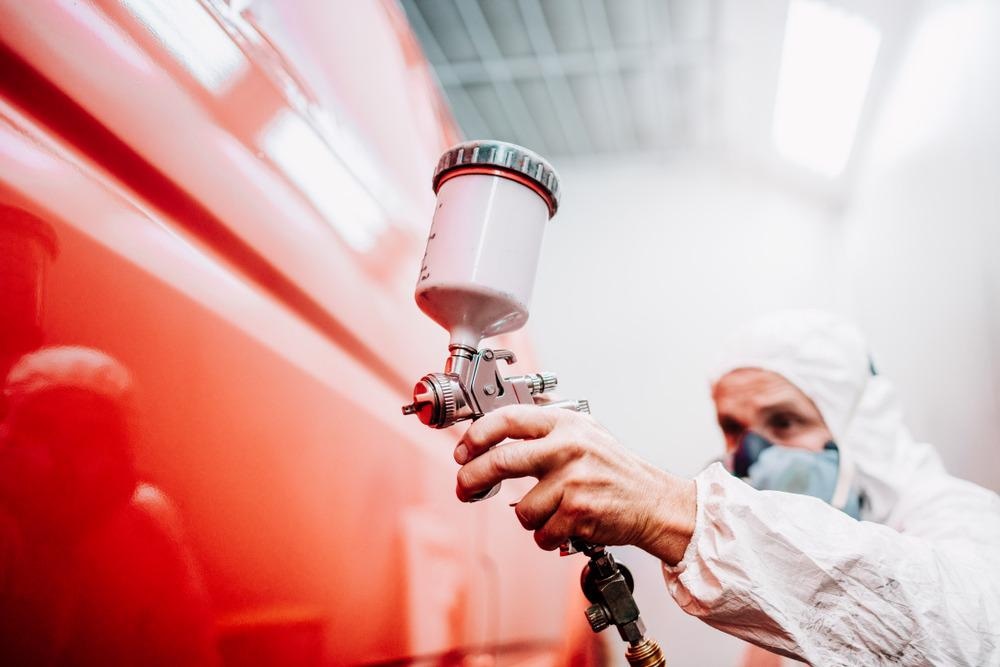This article discusses trace elemental analysis of paints and coatings used in the automotive industry, methods used for this analysis, as well as limitations and risks involved with these methods.

Image Credit: bogdanhoda/Shutterstock.com
What is Trace Element Analysis?
The elemental composition or concentration in any material gives it several properties. These compositions are essential for revealing several qualities such as process operation, product quality, and geographic origin of materials. Trace element analysis or TEA helps us determine small amounts of elements in a given material which often span a large concentration range.
Trace element analysis is applicable in various fields such as forensics, toxicology, metallurgy, petrochemistry, geochemistry, food safety, pharmaceutical testing, environmental monitoring, and many other disciplines.
Automotive Paints and Coatings
Generally, automotive paints have three to four layers that can be different for various manufacturing companies. This individualization and characterization of automotive paints have pushed for advances in scientific investigations.
The introduction of prefilters in studying the IR spectrum of clearcoat is improving the pace of easy identification of vehicles.
The characterization of a paint sample may reveal important information about the source vehicle like layer structure, color, and polymer type, which can be used to identify the model and year of manufacture of the source vehicle.
Methods Used for Elemental Analysis of Paints and Coatings in The Automotive Industry
PyGC
The elemental analysis of paint and coatings starts with a microscopic examination of the sample to determine color and layer structures. After that, a scalpel is used to separate layers for individual examination. This examination includes IR spectroscopy for binder polymer type and organic pigment information and pyrolysis-gas chromatography (PyGC) for additional polymer information.
PyGC is a very powerful method for the characterization of paint layers, especially when it is jointly used with mass spectrometry. However, this method is a destructive type of testing method.
SEM-EDS Spectrometry
SEM-EDS spectrometry is another important method for determining metal particles present in paints. It can detect elemental concentrations above 0.1%, which allows the determination of qualitative concentrations of major and minor elements. However, it lacks sensitivity for trace analysis of paints.
X-Ray Fluorescence Spectrometry
XRF or x-ray fluorescence is another method for the analysis of paint in the automotive industry. This method is more sensitive than SEM-EDS, and concentration detection of up to ten parts per million is possible using XRF. However, a drawback of using XRF is that the penetration capability of X-rays is deep, and the data provided by XRF is from all the layers of paint samples, which makes it difficult for individual layer analysis.
Another disadvantage of using XRF or SEM-EDS is overlapping peaks of lead and sulfur lines and titanium and barium lines, making interpretations challenging when both members are present.
Laser Ablation–Inductively Coupled Plasma–Mass Spectrometry
Laser ablation–inductively coupled plasma–mass spectrometry (LA–ICP–MS) is another method used for detecting elements in paints and coatings. However, trace elemental analysis of paints can be performed using LA-ICP-MS, unlike SEM-EDS. LA-ICP-MS has the capability to distinguish between paints of different sources as well as paints originating from the same source.
LA-ICP-MS is advantageous since it combines two technologies with their respective advantages. LA has a low detection limit and has excellent sensitivity, and ICP-MS is an extremely precise tool. LA-ICP-MS was initially developed to assist several other lab methods for the characterization of organic components in coatings and paints.
Unlike SEM-EDS, LA-ICP-MS is non-destructive since manipulation is not required for sample preparation. Furthermore, only a small quantity of material removal is necessary for analysis since the sampling volume of an ablation takes away a minimal amount of material from the surface. This generally produces a crater of only 100 µm deep with a diameter of 100 µm as well. This benefit of analyzing all paint layers sequentially without needing extensive sample preparation makes LA-ICP-MS very advantageous.
Significance
Trace elemental analysis of paints and coatings used in the automotive industry is gaining popularity in various fields. For instance, in criminal investigations, this analysis is used as evidence, and it may help in establishing the link between a crime scene and a culprit. This analysis compares the physical and chemical composition of automobile paints and matches it with a sample of a known source.
Recent studies have helped scientists develop techniques like LA–ICP–MS, which is a combination of ICP-MS and LA technologies. This has helped in combining advantages such as precision and excellent sensitivity in one method.
More from AZoM: Why Use AFM for the Analysis of Biopolymers?
References and Further Reading
Haag, L. C. (1976). Element profiles of automotive paint chips by X-ray fluorescence spectrometry. Journal of the Forensic Science Society, 16(3), 255-263. https://www.sciencedirect.com/science/article/pii/S0015736876710697?via%3Dihub
Hobbs, A. L., & Almirall, J. R. (2003). Trace elemental analysis of automotive paints by laser ablation-inductively coupled plasma-mass spectrometry (LA-ICP-MS). Analytical and bioanalytical chemistry, 376(8), 1265–1271. https://link.springer.com/article/10.1007/s00216-003-1918-x
Kaur, N., Abi, K. S., Verma, P., & Mahajan, M. (2022). An elemental analysis of Indian automotive paint using SEM-EDS. Materials Today: Proceedings, 48, 1748-1753. https://www.sciencedirect.com/science/article/pii/S2214785321065275?via%3Dihub
Thermofisher.com. Trace Elemental Analysis (TEA) Information | Thermo Fisher Scientific - UK. [online] Available at: https://www.thermofisher.com/uk/en/home/industrial/spectroscopy-elemental-isotope-analysis/spectroscopy-elemental-isotope-analysis-learning-center/trace-elemental-analysis-tea-information.html
Disclaimer: The views expressed here are those of the author expressed in their private capacity and do not necessarily represent the views of AZoM.com Limited T/A AZoNetwork the owner and operator of this website. This disclaimer forms part of the Terms and conditions of use of this website.